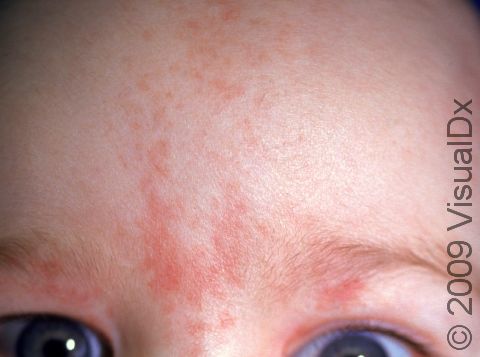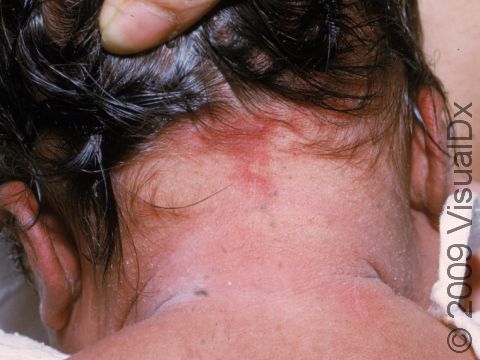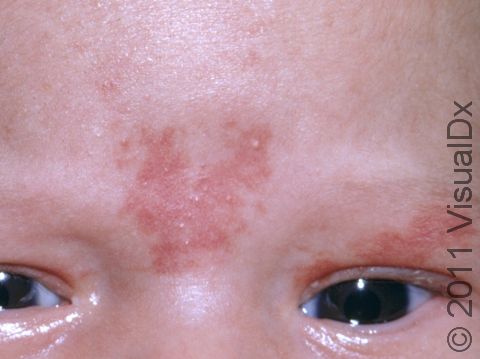Salmon Patch
Salmon patch is the name given to a very common group of birthmarks seen in babies. The birthmarks are caused by expansions (dilations) in tiny blood vessels called capillaries. When a salmon patch occurs on the face, it is often called an angel kiss, and when it occurs on the back of the neck, it is known as a stork bite. These types of birthmarks are very common, and at least 7 in 10 infants will be born with one or more salmon patches. Angel kisses tend to fade by age 1–2 (although some parents report that, for years, when their child cries, the angel kiss temporarily darkens and becomes apparent again), and stork bites tend to not go away at all but are usually covered by the hair on the back of the head. Salmon patches are different from port-wine stains (discussed as a separate topic) in that salmon patches do not grow larger or darker and are not associated with any syndromes involving the brain or development. Salmon patches are always noncancerous. It is sometimes difficult to tell the difference between a salmon patch and a port-wine stain.
In the past, port-wine stains and salmon patches were considered to be variations of the same kind of birthmark, but now it is now known that port-wine stains are truly malformations of capillaries and will never improve on their own, while salmon patches are temporary dilatations (expansions) of capillaries that do typically improve on their own.
Who's At Risk?
Salmon patches are very common (about 70% babies will have one or more of them) and always present at birth. It is thought that salmon patches do not run in families.
Signs & Symptoms
Salmon patches are diagnosed by their appearance. They are pink or red, flat, irregularly shaped patches that appear on the baby’s face or the back of the neck. On the face, they are commonly found between the eyebrows or on one of the eyelids. Salmon patches are never painful or itchy.
Self-Care Guidelines
There is no self-care required for a salmon patch. Treat the skin as you would any other part of the baby, with careful gentle cleansing and moisturization.
Treatments
There is no treatment necessary for a salmon patch. Salmon patches on the face almost always go away on their own within a year or two.
Visit Urgency
The skin of the salmon patch should behave just like the skin on the rest of the baby; if the skin bleeds, develops cracks, if the area becomes darker or more raised or displays any other problems, contact your child’s doctor for further advice.
Trusted Links
References
Habif TP. Clinical Dermatology: A Color Guide to Diagnosis and Therapy, 3rd ed. St. Louis, MO: Mosby; 1996:725-729.
Weston WL. Color Textbook of Pediatric Dermatology. 2nd ed. St. Louis, MO: Mosby Inc; 1996:338.
Wolff K, Goldsmith LA, Katz SI, Gilchrest BA, Paller AS, Leffell DJ, eds. Fitzpatrick’s Dermatology in General Medicine, 7th ed. New York, NY: McGraw-Hill; 2008:2270-2271.
Last modified on October 10th, 2022 at 7:50 pm

Not sure what to look for?
Try our new Rash and Skin Condition Finder


